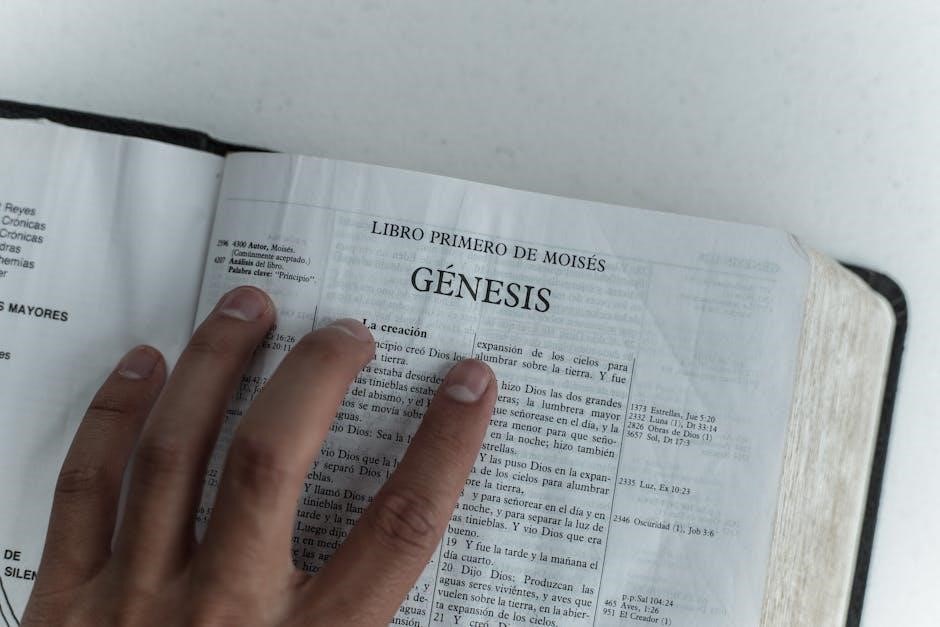Overview of Bible Stories from Genesis to Revelation
The Bible, a collection of 66 books, presents a rich tapestry of stories, from the creation account in Genesis to the prophetic visions of Revelation. These narratives, penned over 1500 years, explore themes of good versus evil, redemption, and God’s relationship with humanity.
Availability of PDF Resources
Many resources offer Bible stories from Genesis to Revelation in PDF format. These include free ebooks, study guides, and visual guides designed for both mature readers and young students, providing accessible ways to engage with scripture.
Free Download Options
Numerous websites offer free PDF downloads of Bible stories, ranging from individual narratives to comprehensive overviews spanning Genesis to Revelation. These resources often cater to diverse audiences, including options tailored for children, students, and adults seeking in-depth study materials. Formats may include illustrated versions, simplified texts, or study guides with questions and answers. These free resources provide accessible ways to explore key biblical events and characters. Some offer visual guides, Bible trivia, and even coloring sheets based on Bible stories. It is also possible to get summaries of Bible stories.
Paid Resources and Study Guides
For more structured learning, paid resources and study guides offer in-depth analyses of Bible stories from Genesis to Revelation. These materials often include commentary, historical context, and theological insights. Options range from comprehensive Bible course PDFs to book-by-book study guides. Some resources focus on specific themes or characters, offering a deeper understanding of their significance. Presbyterian and Reformed authors frequently provide these resources, ensuring biblical accuracy. Many paid options provide detailed outlines, study questions, and maps to enhance the learning experience and can be purchased. These are offered at discounted prices.

Key Stories in Genesis
Genesis lays the foundation with foundational narratives. These include Creation, the Fall, Noah’s Ark, and Abraham’s Covenant. These stories introduce key themes, characters, and covenants that shape the rest of the Bible.
Creation and the Fall
The book of Genesis begins with the creation of the universe and humanity. God speaks, and everything comes into existence. He creates Adam and Eve and places them in the Garden of Eden. In Eden, they are free to enjoy God’s creation, but they are forbidden from eating the fruit of the tree of the knowledge of good and evil. A serpent tempts Eve to eat the fruit, and she shares it with Adam. This act of disobedience is known as the Fall, resulting in sin entering the world and separating humanity from God, changing their relationship.
Noah’s Ark and the Flood
Genesis tells the story of Noah, a righteous man in a world filled with wickedness. God, grieved by the evil on Earth, decides to cleanse it with a great flood. He instructs Noah to build an ark, a massive vessel, and to bring his family and pairs of every living creature onto it. The floodwaters cover the entire Earth, destroying all life except for those on the ark. After many days, the waters recede, and Noah releases birds to find dry land. The ark comes to rest on Mount Ararat, and Noah, his family, and the animals disembark, starting a new beginning for humanity.
Abraham and the Covenant
The story of Abraham is central to Genesis. God calls Abraham to leave his home and journey to a new land that He will show him. God promises to make Abraham the father of a great nation and to bless all peoples through him. This promise is formalized in a covenant, a binding agreement between God and Abraham. As a sign of the covenant, God commands Abraham and his descendants to be circumcised. Abraham’s faith is tested when God asks him to sacrifice his son, Isaac, but Abraham demonstrates his obedience, and God provides a ram instead.
Significant Narratives from Other Old Testament Books
Beyond Genesis, the Old Testament contains many significant narratives. These stories illustrate God’s continuing relationship with Israel, filled with triumphs and trials, showcasing themes of faith, obedience, and the consequences of disobedience.
Moses and the Exodus
The story of Moses and the Exodus is a cornerstone of the Old Testament, narrating the Israelites’ deliverance from slavery in Egypt. God chose Moses to lead His people out of bondage, confronting Pharaoh with miraculous signs and plagues. This narrative showcases God’s power and faithfulness to His covenant. The parting of the Red Sea stands as a pivotal moment, symbolizing divine intervention and the triumph over oppression. The Exodus established Israel as a nation, forever shaping their identity and relationship with God, marked by freedom and divine law.
David and Goliath
The tale of David and Goliath is a powerful narrative of courage and faith found within the Old Testament. A young shepherd, David, armed with only a sling and stones, confronts the Philistine giant Goliath, a seasoned warrior who terrorized the Israelite army. David’s unwavering belief in God’s protection empowers him to overcome this seemingly insurmountable challenge. With skillful aim and divine assistance, David defeats Goliath, becoming a symbol of hope and illustrating the ability to conquer adversity through faith. This story exemplifies how even the smallest among us can achieve great things with God’s help.

Important Stories in the New Testament
The New Testament unveils pivotal stories centered on Jesus’ life, teachings, and sacrifice. It also details the early church’s formation and expansion, showcasing faith, miracles, and the spread of the Gospel message.
The Life and Teachings of Jesus
The Gospels narrate Jesus’s life, from his miraculous birth to his crucifixion and resurrection. His teachings, delivered through sermons and parables, emphasized love, forgiveness, and the Kingdom of God. Jesus’s ministry involved healing the sick, performing miracles, and challenging religious authorities. He demonstrated compassion for the marginalized and offered a new covenant of grace. His death on the cross atoned for humanity’s sins, and his resurrection offered the promise of eternal life. The New Testament highlights Jesus as the central figure in God’s plan for salvation, portraying him as both fully human and fully divine, the Messiah prophesied in the Old Testament.
The Parables of Jesus
Jesus frequently used parables, short allegorical stories, to illustrate spiritual truths and moral lessons. These parables, like the Good Samaritan and the Prodigal Son, conveyed profound messages in relatable terms. They often challenged conventional thinking and encouraged self-reflection. The parables covered a wide range of topics, including forgiveness, compassion, faith, and the nature of the Kingdom of God. They served as a powerful teaching tool, engaging listeners and prompting them to consider the deeper meaning behind the stories. Through these parables, Jesus made complex theological concepts accessible to all, leaving a lasting impact on his followers and subsequent generations.
The Book of Acts: Early Church Stories
The Book of Acts chronicles the spread of Christianity following Jesus’s ascension. It recounts the actions and experiences of the apostles as they established churches and proclaimed the Gospel. Key events include the Pentecost, where the Holy Spirit descended upon the believers, and the conversion of Paul, a former persecutor of Christians. The book highlights the challenges faced by the early church, such as persecution and internal disputes. It also showcases the power of the Holy Spirit in empowering believers to perform miracles and boldly share their faith. The stories in Acts demonstrate the growth and expansion of the Christian faith throughout the Roman Empire.

Themes and Interpretations Across the Bible
Across the diverse narratives, the Bible explores universal themes. Redemption, the battle between good and evil, and God’s covenant with humanity are central. Interpretations vary, reflecting cultural and theological perspectives developed over centuries.
Good vs. Evil
The conflict between good and evil is a recurring motif throughout the Bible, shaping narratives from Genesis to Revelation. The creation story presents the introduction of sin and its consequences, setting the stage for humanity’s struggle. Cain’s murder of Abel exemplifies early manifestations of evil, while Noah’s ark symbolizes divine judgment against wickedness. The Exodus narrates the triumph of good (freedom) over evil (slavery), and the life of Jesus embodies perfect goodness confronting earthly corruption. Ultimately, Revelation depicts a final battle where good triumphs definitively, establishing a new heaven and earth free from evil’s influence, offering hope and resolution.
Redemption and Salvation
The theme of redemption and salvation is central to the biblical narrative, weaving through stories from Genesis to Revelation. God’s covenant with Abraham foreshadows a plan to bless all nations, offering a path to reconciliation. The Exodus demonstrates God’s power to deliver his people from bondage, symbolizing spiritual liberation. Jesus’s life, death, and resurrection embody the ultimate act of redemption, providing atonement for sin. The parables of Jesus illustrate the nature of salvation and the importance of faith. Finally, Revelation promises a new creation where humanity is fully restored to God, experiencing eternal life free from suffering and death.

The Book of Revelation: Key Events and Interpretations
Revelation concludes the biblical narrative with prophetic visions. It depicts the second coming, final judgment, and ultimate triumph of good, culminating in the establishment of a new heaven and earth.
The Second Coming
The Second Coming, a pivotal event in Revelation, signifies Jesus Christ’s return to Earth. This event is associated with judgment, the defeat of evil forces, and the rewarding of the righteous. Interpretations vary, with some viewing it literally and others symbolically. Regardless, it represents the ultimate fulfillment of God’s promises and the restoration of his kingdom. This event is a central tenet of Christian eschatology, inspiring hope and calling believers to faithful living. The narrative emphasizes the victory over sin and death, ushering in an era of peace and justice.
The New Heaven and New Earth
Revelation culminates in the vision of a New Heaven and a New Earth, symbolizing a renewed creation free from sin, suffering, and death. This is not merely a restoration of the original creation, but a transformation into something far more glorious. God dwells directly with humanity, wiping away every tear. The old order has passed away, replaced by eternal peace and righteousness. This vision offers hope and encouragement, promising a future where God’s will is perfectly realized. It is a powerful image of ultimate redemption and the fulfillment of God’s plan for creation.
